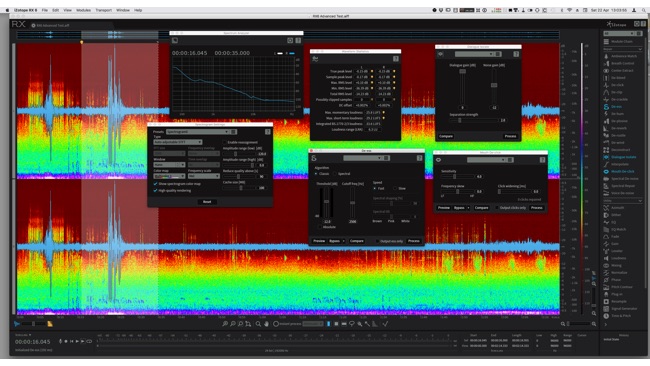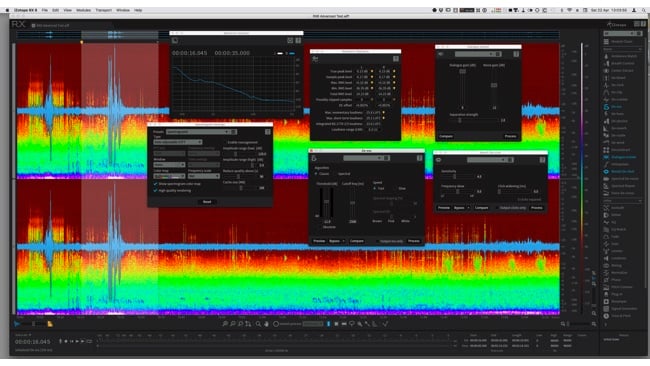
 Fixing audio with the iZotope RX 6 Advanced UI
Fixing audio with the iZotope RX 6 Advanced UI
RedShark Review: iZotope’s RX audio editor received an upgrade just in time for NAB. It repairs, restores and enhances audio and is frequently used to fix sub-par audio in post production.
In a studio, you are in control of ambient sound, noise, etc, but when you’re recording interviews, dialogues and music outdoors, it’s a different story. Luckily, that’s just where RX 6 comes in, and the software is now available in four versions:
RX Elements, a budget-friendly version of RX, featuring the Voice De-noise, De-clip, De-click, De-hum plug-ins and the standalone audio editor.
RX 6 Standard, which includes everything in RX 6 Elements, plus additional features including De-bleed, Spectral De-ess, Mouth De-click and Spectral Repair.
RX 6 Advanced, the premier version of RX that adds De-Wind and advanced features made possible through machine learning, like De-rustle and Dialogue Isolate — this is the version under review.
RX Post Production Suite 2, a comprehensive post-production toolkit for everything from dialogue editing to mixing and delivering. Post Production Suite 2 includes RX 6 Advanced, Neutron Advanced, RX Loudness Control and Insight, as well as a 1-year all-access pass to Groove 3 Video Training and 50 download credits to the Pro Sound Effects Library.
Pricing varies from $129 for RX Elements up to $1499 for Post Production Suite 2, though there are limited time introductory offers on all flavours that takes up to a third off the price (Post Production Suite 2 being available for $999, for instance).
With nine new features included, version 6 is the biggest RX upgrade ever. New are: a Composite View, MP3 export, Breath Control, De-bleed, De-ess, Mouth De-click (all Standard and Advanced), De-rustle, De-wind and Dialogue Isolate (all Advanced only). Of these, I only couldn’t properly test De-rustle and De-bleed.
Machine-learning and intelligent signal processing
In version 6 (and already to some extent in version 5), the major difference between Standard and Advanced is that Standard lacks the intelligent features that are based on machine-learning.
With RX 6 Advanced you can now improve a signal more quickly, more precise and without deep audio processing knowledge in more circumstances. For example, I made a recording of my voice talking to the birds in the back garden with a considerable background noise. It more or less mimicked what you would experience when interviewing someone close to a motorway.
In older versions of RX, I had to use and tweak — often by trial and error — at least two modules to make the monologue stand out from the noise. In RX 6 Advanced, I could do with one module — Dialogue Isolate, which uses a deep neural network — and very little fine-tuning.
De-wind worked in the same, almost magical way. With enough of the occasional gusts of wind to generate the low-frequency blowing sounds I needed, I can say I was surprised by the efficiency of the module. De-wind did need a bit of fine-tuning, especially when the rumbling was strong.
Better workflow
RX has never looked like your typical macOS app, but RX 6 does look much sleeker than its predecessors. In terms of user-friendliness and efficiency, it has improved as well. For example, the Composite View allows you to create a group of your open tabs — holding different ‘clips’ of (often) the same project — and apply your adjustments to all clips simultaneously. There are only a few modules that won’t work with Composite View. Needless to say, this is a very useful feature when fixing audio problems in post as you’re often dealing with audio clips that have been recorded under the same circumstances using the same equipment.
The only condition to make Composite View work is that all your recordings have been recorded with the same frequency and bitrate.
Another new feature that improves efficiency considerably is De-bleed. It relies on a relationship existing between your active track and the Bleed Source track in order to function properly. Of course, both tracks must be time-aligned within a few milliseconds of each other as well.
De-bleed is meant to reduce the leakage of one signal into another, such as when a click track fed into headphones bleeds into an open mic.
If your tracks aren’t time-aligned, RX allows you to shift one track until it matches the timing of the other, creating a silent gap in the first that you can fill using the Signal Generator it has had since the first version. In essence, this means you can even use RX as — granted, manual and therefore more time-consuming — an alternative for PluralEyes.
Tags: Audio



Comments